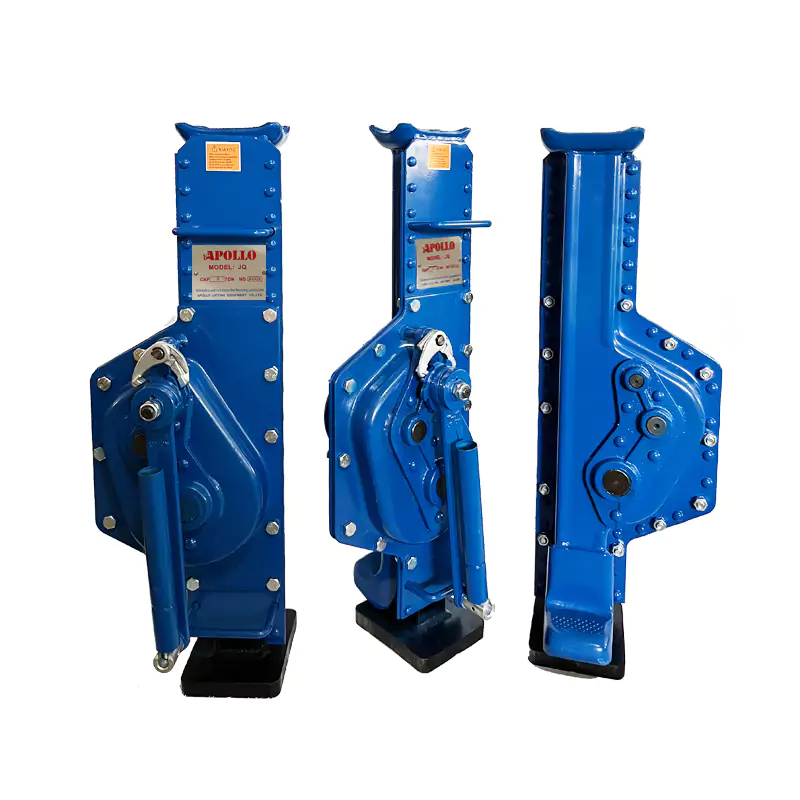Understanding the Basics of a Lifting Jack
What is a Lifting Jack?
A lifting jack is a versatile tool crafted for transferring weight to facilitate the elevation of heavy objects, primarily vehicles. By offering a means of mechanical advantage, it allows users to lift significant weights with minimal physical exertion. Whether dealing with a flat tire on a car or carrying out maintenance on heavy machinery, the lifting jack proves indispensable in various scenarios, ensuring efficiency and safety during lifting tasks.
Types of Lifting Jacks
Mechanical Jacks
Mechanical jacks operate based on gear and ratchet mechanisms. An example is the scissor jack, which uses a screw shaft to transform rotational force into linear motion, raising the load. This type is typically compact, making it a common inclusion in automotive toolkits for emergencies.
Hydraulic Jacks
Hydraulic jacks utilize a hydraulic cylinder and pump to produce the lifting force. These jacks are known for their superior lifting power and efficiency. The bottle jack and floor jack are prime examples, finding extensive use in automotive repair shops and industrial contexts. By leveraging the principle of hydraulics, they can lift heavier loads with greater ease compared to mechanical jacks.
Hangzhou Apollo Lifting Equipment Co., Ltd. supports a variety of packaging options, including paper packaging, wooden box packaging, and barrel packaging. This flexibility ensures that their products can be tailored to meet the specific requirements of different applications, thereby enhancing the overall efficiency and reliability of the weighing process. The company’s commitment to quality and precision is evident in their meticulous approach to packaging, which plays a crucial role in maintaining the integrity and accuracy of crane scales during transportation and storage.
APOLLO’s range of lifting jacks is engineered to cater to a broad spectrum of lifting needs, from automotive repairs to industrial applications. These jacks are designed with a focus on safety, durability, and ease of use, making them an ideal choice for both professionals and novices alike. APOLLO’s lifting jacks come in various models, including bottle jacks, floor jacks, and scissor jacks, each tailored to specific lifting tasks and weight capacities.
One of the standout features of APOLLO lifting jacks is their robust construction. The use of high-grade materials ensures that the jacks can withstand the rigors of heavy lifting without compromise. Additionally, APOLLO jacks are equipped with safety mechanisms such as overload protection valves and stable base designs, which provide added security during operation.
The ergonomic design of APOLLO jacks also facilitates a user-friendly experience. They often include features such as comfortable handles and smooth lifting mechanisms, which allow for precise control over the lifting process. This precision is essential for beginners who are learning the intricacies of safe and effective lifting techniques.

Common Uses of a Lifting Jack
Lifting jacks are primarily utilized in automotive maintenance, such as changing tires, repairing brakes, or conducting inspections. They also prove beneficial in industrial applications, including lifting heavy machinery for installation or maintenance. Another common use is in the construction industry for structural alignment or adjustments. By enabling safe lifting and providing stability, lifting jacks are critical tools in various professional and personal projects.
Preparing for Safe Operation
Essential Safety Precautions
Before operating a lifting jack, it is essential to wear the proper safety gear. This involves putting on gloves to safeguard your hands against injuries, safety glasses to protect your eyes from any debris, and durable footwear to avoid foot injuries. Being properly protected helps reduce the risk of accidents during the use of the lifting jack.
Checking the Stability of the Surface
The stability of the surface where the lifting jack will be used is paramount. Ensure that the ground is solid and level to prevent the jack from slipping or tilting, which could lead to accidents. Avoid using the jack on uneven or unstable surfaces, as this compromises the safety and effectiveness of the lifting process.
Tools and Accessories Required
Using a lifting jack effectively requires specific tools and accessories. Key tools include wheel chocks to prevent vehicle movement and jack stands to secure the lifted object. A tire iron or a breaker bar is also necessary for loosening and tightening wheel nuts. By having all required tools on hand, you ensure the lifting process proceeds smoothly and safely.
Step-by-Step Guide to Using a Lifting Jack
Positioning the Vehicle or Object
Identifying the Lift Point
Accurately identifying the lift points on the vehicle or object is essential. For vehicles, manufacturer guidelines usually mark the recommended jack points. These areas are structurally reinforced to handle the weight without causing damage. Always consult the vehicle’s manual if unsure.
Ensuring Proper Alignment Position the lifting jack accurately beneath the designated lift point. Misalignment can lead to damage to the vehicle or object and may pose safety risks. It’s crucial to take a moment to verify that the jack is correctly placed before you start lifting.
Operating the Lifting Mechanism
Using a Mechanical Jack
To operate a mechanical jack, start by turning the screw handle slowly. As you turn, the scissor mechanism will expand, elevating the lift arm. Continue rotating until the vehicle or object reaches the desired height. Always maintain a steady pace to avoid sudden movements that could destabilize the load.
Using a Hydraulic Jack
For a hydraulic jack, begin by closing the release valve by turning it clockwise. Pump the handle repeatedly to build pressure in the hydraulic cylinder, which lifts the arm. Once the desired height is achieved, stop pumping and ensure the load is stable. Opening the release valve gently lowers the load when finished.
Securing the Lifted Object
Using Jack Stands and Other Supports
Once the vehicle or object is elevated, immediately secure it using jack stands or other supportive devices. Place the jack stands under the lift points and slowly lower the jack until the load rests securely on the stands. By using supports, you provide additional stability, ensuring safety while working under the lifted object.
Adhering to these guidelines and precautions while using a lifting jack reduces the likelihood of injury and equipment damage, ensuring the lifting process is both effective and safe. Consistently follow safety standards and manufacturer instructions to obtain optimal results in your lifting activities.
Maintenance and Care Tips for Your Lifting Jack
Regular Inspection Procedures
Regular inspection is crucial to ensure that your lifting jack operates safely and efficiently over time. Begin by checking for any signs of wear and tear on the lifting mechanism, particularly on the screw or hydraulic components. Look for any cracks or distortions in the metal frame that could compromise the jack’s integrity. Additionally, inspect the handle for bends or damage, as a bent handle can make the jack difficult to operate and potentially dangerous. Lubricate any moving parts, if recommended by the manufacturer, to maintain smooth operation and reduce wear.
Also, verify that the lifting jack can still hold pressure when lifted. For hydraulic jacks, check the hydraulic fluid level regularly and top it up if necessary. A low fluid level can affect the jack’s performance and may result in failure during operation. Conduct these inspections before each use to catch potential issues early and prevent accidents or failures during lifting.

Proper Storage Practices
Proper storage of your lifting jack is essential to prolong its lifespan and maintain its functionality. Store the jack in a dry, clean area to prevent rust and corrosion. Moisture and dirt accumulation can significantly degrade the jack’s components over time. Position the jack in an upright position to avoid any unnecessary pressure on the mechanism, which could lead to deformation or damage. Additionally, keep the jack covered when not in use to protect it from dust and other environmental factors.
If your lifting jack is hydraulic, make sure to store it with the release valve closed to keep the hydraulic pressure intact and avoid fluid leaks. For mechanical jacks, retract the lifting arm to its lowest position before storing it to reduce exposure and possible damage. Adhering to these storage practices helps maintain the jack’s operational efficiency and prolong its service life.
Final Thoughts on Using a Lifting Jack Efficiently
Using a lifting jack efficiently is about more than just following the correct lifting procedures. It requires a comprehensive approach that includes preparation, operation, and maintenance. By understanding the different types of lifting jacks and their applications, preparing adequately for each lift with the necessary tools and safety gear, and following step-by-step operational guidelines, you ensure that every lifting task is carried out safely and effectively.
Additionally, the importance of regular inspections and proper storage cannot be overstated. These maintenance practices help identify potential issues before they become serious problems and ensure your lifting jack remains in good working condition for as long as possible. By incorporating these habits into your routine, you maximize both the safety and efficiency of your lifting operations.
In summary, a lifting jack is an invaluable tool when used correctly and maintained properly. Whether you are a beginner or have some experience, adhering to these guidelines will enhance your ability to lift heavy objects safely and reliably, providing peace of mind and ensuring successful outcomes for your projects.


